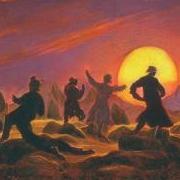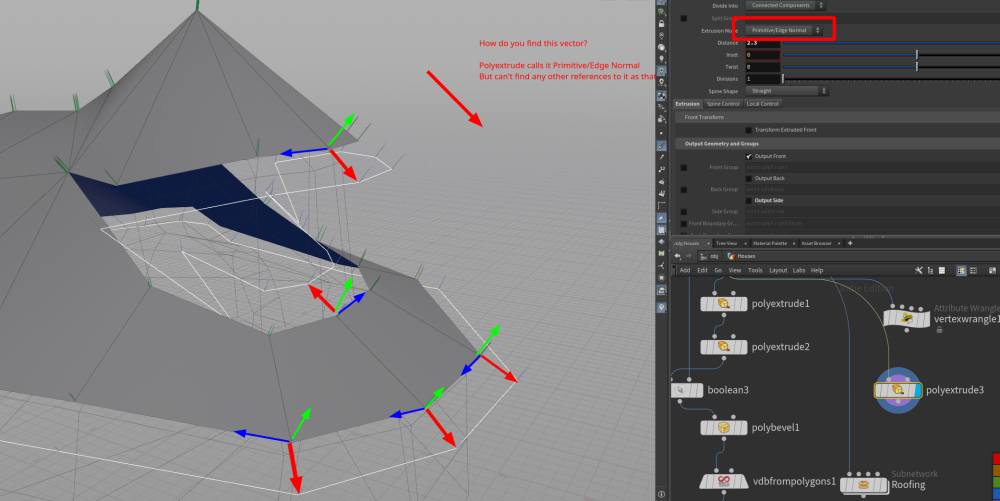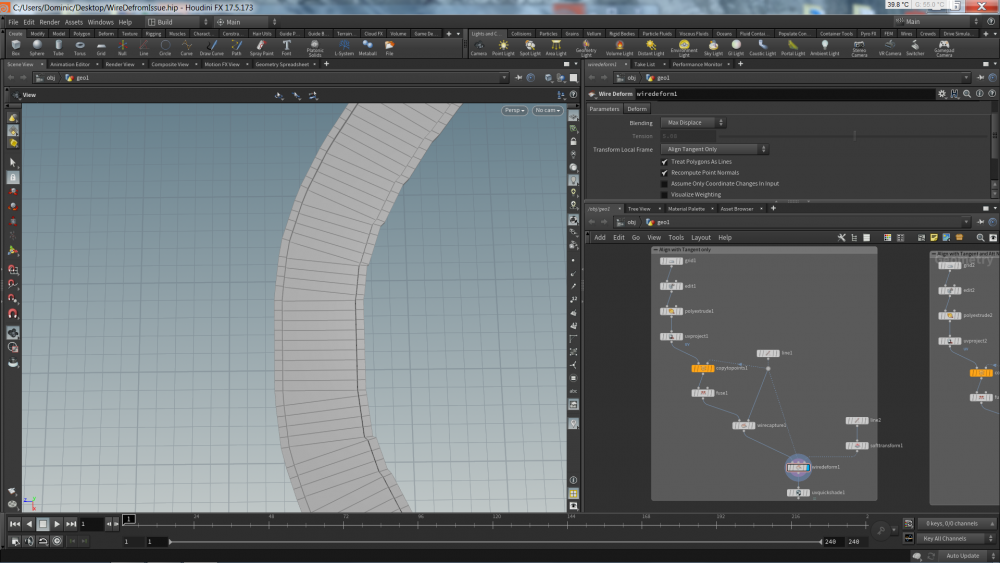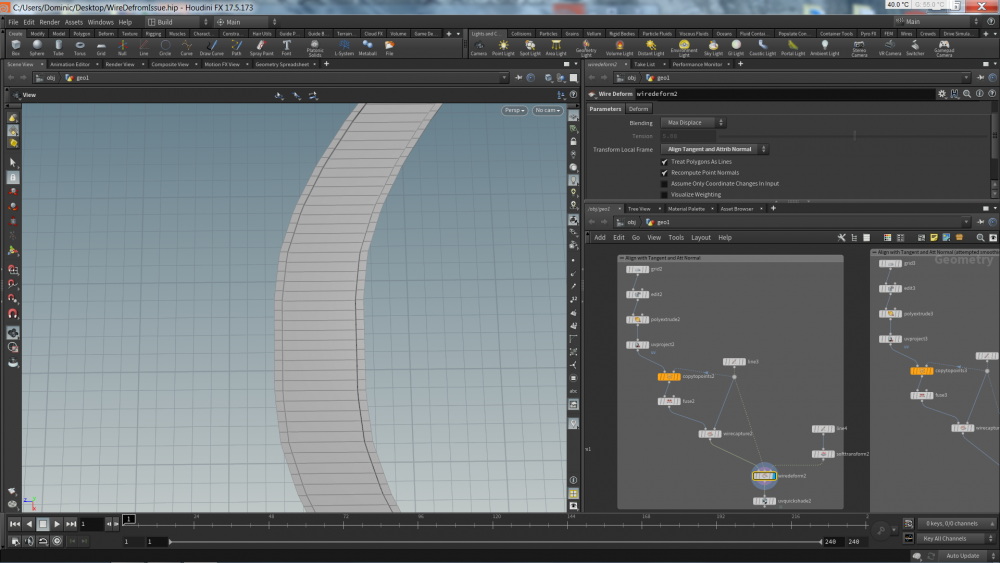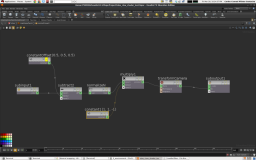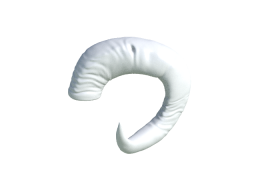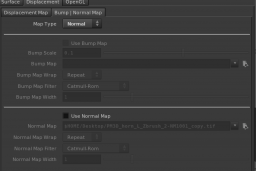Search the Community
Showing results for tags 'tangent'.
-
Hello there! How would you calculate the vector depicted as the red arrows in the image. PolyExtrude node uses it when given an unshared edge group. I've tried a polyframe's tangentu and tangent crossed in vex with the Normal. Without luck. It doesn't seem to be just a continuation of each points inner edges (the not unshared ones.... :/ ). But can't wrap my head around where to go with it. Thanks
-
Hey folks, proud to present LYNX Tools, a collection of production proven open source tools to accelerate your workflows! All mentioned tools are free to download via the links below and are licensed with a full HoudiniFX license. All Houdini Assets have complete Houdini native documentation available. Repository: https://github.com/LucaScheller/VFX-LYNX Lastest stable release: https://github.com/LucaScheller/VFX-LYNX/releases Please give them a test drive, so we can improve them further Roadmap | https://github.com/LucaScheller/VFX-LYNX/projects/1 So far there are three tools: LYNX_force_general | Tweak your sims with this all purpose & intuitive force field. Built to mimic force fields in other DCC applications, but with support for more features and a natural Houdini user experience. https://www.lucascheller.de/vfx/2019/03/24/vfx-lynx-houdini-force-general-asset/ LYNX_fabric | Create fabric/weave patterns with ease. Perfect for creating that holiday sweater you never wanted. https://www.lucascheller.de/vfx/2019/03/16/vfx-lynx-houdini-fabric-asset/ LYNX_velocity | Get control of your velocities via an intuitive UI or groom them for absolute fine tuned control. https://www.lucascheller.de/vfx/2018/11/01/vfx-lynx-houdini-velocity-asset/ More info on my website, including full release logs: https://www.lucascheller.de/blog/ Houdini User Group Munich Presentation: https://vimeo.com/334887452
- 13 replies
-
- 10
-

-

-
I am struggling a bit to build a setup that can bake DPdu/dv onto the points/vertex of an object. I am trying to then pass this info onto a series of scattered points across the surface that I am caching before passing to another application. The issue is I cannot seem to calculate DPdu for instance on a surface in a SOP network. Apparently Du(), primduv(), etc all don't work in sops and only in shading networks. I have got something kind of working using the polyframe node. But the issue is it isn't doing exactly what i need, specifically it seems to be normalizing the vectors. It says there is an option to orthogolize the output tangentu,tangentv vectors but does seem to be doing that wether that option is checked or not. Basically I have a box for instance with UDims uv's assigned, and several of the sides have the uvs rotated 45 degrees and zoomed in. When i view the resulting tangentu/tangentv coming out of the polyframe node they seem to pick up the correct orientation, and are indeed rotated 45 degrees on the facts that are rotated. However the vectors all seem to be normalized to be 1 in size. So I cannot then look at the vector size to get texel density/scale for the surface. So basically is there a way to get the tangentu/v on a surface from the uv's coming in for an object, such that I can figure out the texel density and at the same time the orientation of the uv's on the surface? I guess if i could get the scale factor for u or v in world space that would be also enough. I mean basically I just want the rare unnormalized DPdu values for a piece of geometry that I can then assign to points I scatter across the surface as an attribute? I have banged my head against this for a day now, so really appreciate any insights the geniuses on this forum might have, that would save me another day or so of trying to figure this out.
-
Hello guys, I am trying to recreate a tangent space blend shape in Houdini. Coming from Maya, I used a lot of tangent space blend shape to correct bad poses, and if fairly simple using the shape editor in newer Maya version. Now the question is, how can I create a similar custom blend shape in Houdini? Thanks for your help Gianluca
-
- blendshape
- tangent
-
(and 2 more)
Tagged with:
-
Hi all, Ive recently started looking in to using the wire capture and wire deform SOPs, all is going well however, when deforming on a simple bend i am having to compromise between mesh curvature and stretching Uvs. It seems that toggling between "Align Tangent only" and "Align Tangent with Att Normal" on the wire deform gives me these two different effects. My question is, is there a way to achieve a deformation that effectively smooths out the aligned tangent? (i thought maybe setting my normals as tangent u and smoothing them would help but it has no effect.) Aligned tangent only - Aligned with Att Normal - Thanks all! WireDefromIssue.hip
-
Hi, The picture shows an object , create > test geo > add velocity > vdbFromPolygon with vel field > visualize velocity. I wonder how to split velocity to tangent velocity and normal velocity. I guess we don't have a node to do it by one click, and need to work on volume vop/wrangle. If anyone knows how to do it, I will appreciate it, thanks!
-
Hey Guys! In a recent demo vid on how Houdini can be used in games, they showed how ocean fx can be used to create normal maps for fluid. at 7:46 I'm just wondering, how do I render the normal map? So far, I unwrapped my grid, and used polyframe to get my normal, tangent and bitangent. But I'm unsure on how to get the colour to reflect the correct values. From a lot of reading, it looks like I have to orient my current normal to turn it into tangent space? I've given it a guess, but it doesn't look right. My next step is then how do I bring this into COPS (what it looks like he's using) to save the normal map out? Thanks a lot! fluid_texture_02_HALP.hipnc
-
I recently came across Zach's awesome work and saw this piece. Started hunting down how to achieve such an effect and found circle tangent chains is what they are called. I couldn't find out how to actually make one though? Does anyone know where I can find more info or how to do this? I was also thinking the bullet solver maybe good for this? Any ideas greatly appreciated
-
Hello guys I need some help. I am trying to get a nice tail for the marbles in this DOP simulation. Under the Geometry node "Geometry Velocity Blur" us checked and in the Mantra node I am enabling to render Motion Blur. Is there a way to re-calculate the direction of the blur based on the particle's velocity? Cannot figure out why the direction of the blur sometimes is even perpendicular to the velocity vector! Here is the video: https://vimeo.com/112666106 Any suggestion? Thanks a lot guys!
- 5 replies
-
- dop
- motion blur
- (and 5 more)
-
Hello everyone, I am trying to apply some normal maps in tangent space to some models. I used both Zbrush and xNormal for exporting the normals, none of them work. As far as I understand it, there are two types of normal maps, tangent and object space. Since the geometry will be deformed, I am using NM in tangent space. I wanted to use the default mantra surface model first, to see how it works, but it doesn't work in the first place. It basically takes in a normal map and then uses the convertNormal subnetwork (posted below). The some of the channels still seem flipped. I tried flipping other channels using the multiply node, but it simply does not work. I have tried looking it up, and there are some pretty ancient threats. One of them also provides an example file, but it seems houdini changed a bit since then. http://www.sidefx.com/exchange/info.php?fileid=561&versionid=561 The VEX function vop_computeTangents($tanU, $tanV, normalize(N), $uv, 2); does not expect the same input anymore. I haven't really worked with VEX code yet, so I am a bit stranded here. Isn't there a fast way to set tanget space normal maps up? I can't believe such a simple thing is so hard to set up. Do I need to flip certain channels when I export the NM? Am I overlooking something, or am I just really stupid? Any kind of help or information is welcome Thanks a lot Sustaxa
- 18 replies
-
I don't know why, but I've never successfully been able to import a normal map into houdini from zbrush or mudbox. I've had this issue for a year now, and I always just do bump instead. It works, but I'd rather have a tangent space normal map. Both tangent space and object space appear to screw up the lighting in Houdini renders. I'm using the mantra surface shader, default with houdini 13. Anyone know how to get this to work without the harsh edges on the shadows? Image 1 shows how the object looks with a normal map plugged in Image 2 shows how the object looks with "normal" selected from the drop down menu without the map being checked on. Image 3 shows how it looks without the normal option being selected from the drop down menu, just regular obj, no maps. Image 4 shows what I mean by "drop down menu" This is not the problem with the obj or the maps. They work fine in maya. Something weird is happening in Houdini. Thanks!!!
- 1 reply
-
- normal map
- normal
- (and 4 more)

